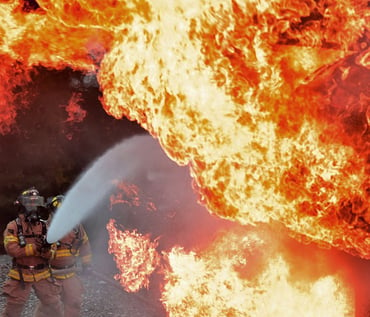 You would think that an explosion caused by combustible dust would be the biggest concern during a fire, but these situations create the opportunity for a dangerous fire situation- a backdraft. A backdraft is a sudden swelling of flames when oxygen has been suddenly reintroduced into a burning area that was low on oxygen.
You would think that an explosion caused by combustible dust would be the biggest concern during a fire, but these situations create the opportunity for a dangerous fire situation- a backdraft. A backdraft is a sudden swelling of flames when oxygen has been suddenly reintroduced into a burning area that was low on oxygen.
When a fire is burning in a closed area it will eventually burn all of the oxygen as fuel, and the fire will die down and smolder and smoke heavily. The fire triangle requires Fuel, Heat, and Oxygen for a fire to burn, so once all the oxygen has been depleted the fire will go out, but the embers will still be burning extremely hot. Consuming the oxygen also means the closed room will have a negative pressure inside it, and a sure sign that a backdraft is forming is that air will be sucked in through any available opening or crack.
If oxygen is reintroduced back into the room, it will come in with a force because of the negative pressure, and the smoldering embers will reignite explosively at extremely high temperatures. The oxygen can be reintroduced when someone opens a door, or a window breaks, or a hole is burned through a wall or ceiling. This is one reason why people are taught not to open a door during a fire in their home, the sudden influx of oxygen can cause a small smoldering fire to turn into a huge blaze.
A backdraft can be extra dangerous in the presence of combustible dust, because the sudden explosion of oxygenated flames can reignite dust that did not burn completely, creating a dust explosion out of the burst of flames. One of the elements of the Dust Explosion Pentagon is Oxygen, and this sudden increase in oxygen, combined with the movement of the flames, can create a dust cloud and a combustible dust explosion on top of the backdraft.
Want to clean combustible dust and avoid a backdraft in your facility?
Contact a Hughes Environmental representative to learn how we can help you avoid fire & explosion hazards in the workplace.

